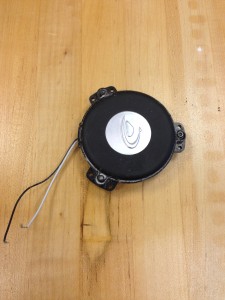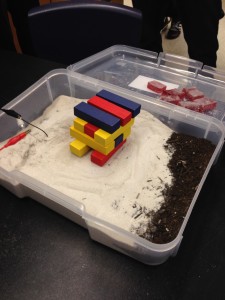Round 3: Final Prototype
Dec 3rd, 2014 by ukleja
ROUND 3:
Our third round of prototyping consisted of a single prototype. After considering the user feedback, the teacher feedback, and the course content, we decided to create an earthquake simulator that used sound waves, as opposed to mechanical vibrations, to simulate an earthquake. We determined that music/sound was a key part in keeping the students engaged. Also, an earthquake simulator met both requirements of having the device be relevant to the course and be destructive in nature (as per the students’ feedback).
Our initial attempt at creating this device consisted of placing the large sub-woofer in the bottom of a container and covering it with sand. Much to our surprised, this failed. The speaker was not strong enough to move the sand in the manner we wanted.
Despite this, we proceeded with this design and instead focused on the material to be used for the buildings. We theorized that, even if the sand did not move violently, we could still knock down buildings if they were made of the correct material. With this in mind, we tried several different materials: sand castles with different sand-to-water ratios, jello, foam blocks, etc. No matter what we tried, the vibrations were still not strong enough to effectively knock down a “building.”
After this failure we thought we would have to drastically change our design. We had wanted to use sand, pebbles, and soil as the medium in order to more closely simulate actual earthquakes, but these appeared to heavy for the speaker to move. Our initial thoughts were to change the medium to something far lighter (plastic beads, packing peanuts) and less realistic in order to gain any form of functionality. This, however, proved unnecessary. One of our group members discovered a fault in our wiring that was preventing the speaker from using the full power of the amplifier. Once fixed, the speaker produced considerably stronger vibrations but, after testing, they still were not strong enough.
At the suggestion of Professor Eglash, one of our group members met with Professor Navid Attary. Professor Attary works with earthquake simulations in STEM outreach and proved to be a wealth of knowledge. After some correspondence, it was suggested that, instead of using a speaker or sub-woofer, we use a tactile transducer. This is a special type of speaker, most often used in Gaming chairs by video-game players, that translates the low frequencies in audio waves to actual physical vibrations. In the gaming sense, it allows gamers to “feel” the video game and thus immerse themselves in it. For our purposes, it proved to provide strong enough vibrations to move the sand and knock downing model buildings.
The final, working prototype consisted of a 3″ deep tray filled with sand. The tactile transducer was immersed in the sand and connected to the amplifier which, in turn, was connected to either a laptop or iPhone. A song with low frequencies (i.e. deep bass) was then played and the transducer produced strong enough vibrations to knock down buildings. After further testing, we determined that the best material to use for the model buildings was jenga blocks. These allowed the students to build multiple building designs and they were just the right density to effectively simulate the destruction of buildings during earthquakes.



